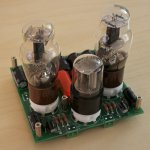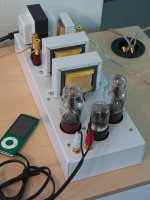I hand-wired about three Darling tube amps a few years back and decided to revisit the design. I had my fill of point to point so decided to lay out a PCB.
Here is Oh! Darling:

I built two now ... into rather poor enclosures. But they sound awesome.
Thanks to the community that have shared the Darling design.
For the office or a relaxing evening in the living room, these amps are hard to beat.
Here is Oh! Darling:

I built two now ... into rather poor enclosures. But they sound awesome.
Thanks to the community that have shared the Darling design.
For the office or a relaxing evening in the living room, these amps are hard to beat.
Last edited:
Schematic is the vanilla 1626 Darling schematic floating around. I've seen one from 2005 attributed to Tom McNally.
The PCB went through a couple iterations to get where it is. Finally I was able to get it under 21 square inches to qualify for a discount on board pricing. (The board contains PS circuitry and I wanted the caps lying on their sides ... so that made it a challenge.)
For low power amps like the Darling, I like PCB's. Primarily I guess because of how clean they look and how quickly you can stuff the boards.
I had a hand-wired push-pull go south on me and the prospect of "detangling" it in order to diagnose/repair it was daunting. I just wanted to do a "board swap" and be done with it.
The PCB went through a couple iterations to get where it is. Finally I was able to get it under 21 square inches to qualify for a discount on board pricing. (The board contains PS circuitry and I wanted the caps lying on their sides ... so that made it a challenge.)
For low power amps like the Darling, I like PCB's. Primarily I guess because of how clean they look and how quickly you can stuff the boards.
I had a hand-wired push-pull go south on me and the prospect of "detangling" it in order to diagnose/repair it was daunting. I just wanted to do a "board swap" and be done with it.
The "Darling" 1626 amplifier was designed by Bob Danielak in the late 1990s. The design was published in Sound Practices Magazine issue 15.
I built one about a year ago using the DIYTUBE board. It uses a single 12SL7 as a driver. Your board is considerably smaller.
You are right that these are fun little amps. I have mine at my work bench with a cheap pair of Radio Shack full range speakers placed only a few feet from my head so, little power is required. I feed it with my iPhone. Not the last word in hi-fidelity but fun for sure. And the tubes are cheap.
You are right that these are fun little amps. I have mine at my work bench with a cheap pair of Radio Shack full range speakers placed only a few feet from my head so, little power is required. I feed it with my iPhone. Not the last word in hi-fidelity but fun for sure. And the tubes are cheap.
Be careful that the electrolytics by the standoffs in the corners don't short to the standoffs. Depending on the amount of clearance, you might want to give them a piece of Kapton tape. The exposed metal on the top of those 'lytics is connected to the negative terminal of the cap.
Another approach would have been to place the tube sockets on the bottom layer - like you did with the terminal blocks. Components on top, tubes on bottom. Then, once assembled, flip the assembly to let the tubes poke out of the chassis. Your layout is more compact, though. I like it...
~Tom
Another approach would have been to place the tube sockets on the bottom layer - like you did with the terminal blocks. Components on top, tubes on bottom. Then, once assembled, flip the assembly to let the tubes poke out of the chassis. Your layout is more compact, though. I like it...
~Tom
I forgot to thank those that contributed to the Clementine amp as well: there were a lot of good ideas in the (Darling) Clementine as well.
@MikeR: Yeah, full-range are nice. I threw on a sub though to pick up the bottom end a bit.
@tomchr: Thanks, I do worry about components too close to the stand-offs. In fact there's 3/16" to 1/4" though. I'll have to see what this Kapton tape is though — sounds useful. Thanks.
@MikeR: Yeah, full-range are nice. I threw on a sub though to pick up the bottom end a bit.
@tomchr: Thanks, I do worry about components too close to the stand-offs. In fact there's 3/16" to 1/4" though. I'll have to see what this Kapton tape is though — sounds useful. Thanks.
Kapton tape can tolerate extreme temperatures (-100 to +500 F; -73 to +260 C) and has a high dielectric breakdown strength (typ. 7 kV). It's very handy for applications where you need electrical isolation and need the tape to remain in place even at elevated temperatures. As you can guess from the specs, it's also rather pricey. But having a short roll of 1/2" wide Kapton (link below) available is handy at times.
1/2-5-5413 3M (TC) | 3M10235-ND | DigiKey
But with 3/16"~1/4" from the end of the 'lytic can to the metal standoff, you probably don't have anything to worry about in this particular circuit. It looks much closer, though. Especially in the front right corner of the board pictured above. Another approach is to get 'lytic cans that have a plastic disc on the top isolating the can from the outside world.
~Tom
1/2-5-5413 3M (TC) | 3M10235-ND | DigiKey
But with 3/16"~1/4" from the end of the 'lytic can to the metal standoff, you probably don't have anything to worry about in this particular circuit. It looks much closer, though. Especially in the front right corner of the board pictured above. Another approach is to get 'lytic cans that have a plastic disc on the top isolating the can from the outside world.
~Tom
Last edited:
@tomchr: You're right, I didn't have the board in front of me when I claimed 3/16". Now that I have it with me, it's a shy 1/8" for the front stand-offs (the other stand-offs are not a problem). I may try slipping a short length of vinyl tubing around the stand-off as well....
- Status
- Not open for further replies.
- Home
- Amplifiers
- Tubes / Valves
- Oh! Darling
